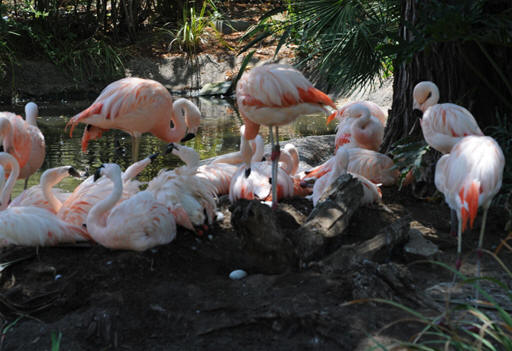How does this bird interact with other species?
As stated before in the
reproduction page, the Chilean
flamingo can be very aggressive towards other birds, and even
humans. This bird may seem like a calm, peaceful animal, but
when a group surrounds together, they can be quite rough.
Phoenicopterus chilensis stay grouped in flocks of almost
20,000 birds (Bucher et al. 2012). It is claimed that larger
bondage groups of flamingos have higher aggression rates
compared to single birds (Dampier et al. 2010). It is
very difficult for scientists to survey colonies in the
wild because there are so many birds in one colony. Also, it is
difficult to pick out the behavior of one particular bird. The
majority of Chilean flamingos are held in captivity to be able
to observe their behaviors (Dampier et al. 2010).
Human interactions with this type of flamingo have many negative
effects on the bird. The Chilean flamingo is classified as
near-threatened due to humans illegally collecting the eggs
while they are unsupervised (Dampier et al. 2010). Also, humans
add to the habitat loss of these birds because they mine, tour
and hunt on these grounds (Field Guide). They are hunted for
their feathers, their meat, and just for sport (Field Guide).
Andean miners believe that the tongue of the Chilean flamingo is
the cure for tuberculosis, so when they hunt these birds, they
cut out their tongues (Field Guide). Also, humans keep these
flamingos in zoos because they think flamingos are entertaining
to watch (Field Guide).
While aggression rates increase
during reproduction breeding periods (Barry et al. 2000), there
is no significant difference on which sex has a higher
aggression towards other flamingos (Baldassarre et al.
1992). But it is claimed that adults are more aggressive than
juveniles. An “aggressive” behavior is when one or both of
the birds stretch their necks out and start pecking at the other
individual (Beaumont et al. 1992). Acts of aggression can cause
egg breakages or misplacements in such large groups (Barry et
al. 2000). This is another reason why reproduction rates are so
low, because the roughness of these birds causes egg fatalities.
Predator-prey relationships between
organisms are very important. For the Chilean flamingo, they
feed on mostly plankton and invertebrates that live in the
benthic zone of lakes (Hurlbert 1982). They also feed on
zooplankton (Hurlbert 1982). If the flamingos have eaten all of the
plankton and have nothing else to eat, they feed on seeds that
they find on the shore of lakes. Humans are the Chilean
Flamingos main predator (Conservation Patagonica News).
The relationship between chicks and
parents is less aggressive and highly beneficial when the
flamingos are in a quieter, more secluded habitat (Lee
Richardson Zoo 2014). This way there are no other flamingos to
step on their nests, and there are no humans that can invade on
their homes. After the egg has hatched, both the mother and the
father have a nutrient-rich liquid that they feed the chick
with. This crop milk is located in their upper digestive tracts
(Lee Richardson Zoo 2014). When the actual parents of the chick raise it
themselves, and keeps watch over them, it gives the chick the
skills and the experience to be a better parent when they
reproduce (Lee Richardson Zoo 2014). Also, parents find their chicks by voice
recognition, so if the parents raise the chicks themselves, it
will be easier to find their children in the large groups of
flamingos (Lee Richardson Zoo 2014).
